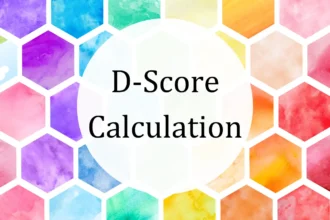Gymnastics scoring might seem mysterious at first, but at its heart is a straightforward concept: each skill in a routine has a difficulty value.
The FIG (International Gymnastics Federation) uses an A-to-J scale to assign these values. This guide will break down how the scale works, how values are determined, and why they matter.
What Is the A-to-J Scale?
The A-to-J scale is a system that rates every individual element or skill in a gymnast’s routine by its level of difficulty.
- A represents the simplest skills (each worth 0.1 point).
- The scale climbs with increasing difficulty—B is 0.2, C is 0.3, and so on.
- In men’s gymnastics (MAG), the highest rated skill is an I element (0.9 points).
- In women’s gymnastics (WAG), some skills go even higher, with a J element valued at 1.0 point.
When a gymnast introduces a new move, it goes through this evaluation process before being added to the Code of Points.
Difficulty Value Scale with Examples
Note: Actual letter-value assignments vary between men’s and women’s gymnastics. The examples below are primarily from WAG.
| Letter | Point Value | Example Skill (Women’s Artistic) |
|---|---|---|
| A | 0.10 | Cartwheel on beam, split jump, handstand hold |
| B | 0.20 | Front handspring vault, back handspring on beam, aerial (floor) |
| C | 0.30 | Front aerial (beam), back tuck salto (floor) |
| D | 0.40 | Double pike (floor), Shaposhnikova (bars), aerial cartwheel (beam) |
| E | 0.50 | Double Arabian (floor), Pak salto (bars), double layout salto |
| F | 0.60 | Amanar vault, triple full twist (floor) |
| G | 0.70 | Double-double layout (floor), Bhardwaj (bars) |
| H | 0.80 | Silivas (double-double tuck, floor) |
| I | 0.90 | Biles I (triple-double salto, floor) |
| J (WAG only) | 1.00 | Biles II (Yurchenko Double Pike vault) |
A Closer Look at the Categories
A Skills: The Easiest Category
- Value: 0.1 points
- Examples: Forward roll, handstand, tuck jump, split jump
- Foundation of routines; execution is more important than difficulty.
B Skills: Slightly More Challenging
- Value: 0.2 points
- Examples: Back handspring, front handspring, aerial (no hands)
- Building blocks for acrobatics and connections.
C Skills: Moderately Difficult
- Value: 0.3 points
- Examples: Back tuck (floor), switch leap ½, aerial cartwheel (floor)
- Begin incorporating flips, twists, and more intricate combinations.
D Skills: Advanced Elements
- Value: 0.4 points
- Examples: Double back salto, Shaposhnikova (bars), aerial cartwheel (beam)
- Seen in elite gymnastics, requiring strong technique and control.
E Skills: High-Level Moves
- Value: 0.5 points
- Examples: Double Arabian (floor), Pak salto (bars), double layout salto
- Common at the international elite level; often highlight skills in routines.
F, G, H, I, J Skills: Ultra-High-Level Moves
- Value: 0.6–1.0 points
- Examples:
- F: Amanar vault, triple twist salto
- G: Double-double (floor), Bhardwaj release (bars)
- H: Silivas (floor), Shirai 2 (MAG)
- I: Biles I (WAG, floor), Shirai 3 (MAG)
- J (WAG only): Biles II – Yurchenko Double Pike Vault
As the letters climb higher, the difficulty and risk escalates. Skills at the G to J level are reserved for elite gymnasts.
How Difficulty Values Impact the D-Score
In gymnastics, the Difficulty Score (D-score) is built on the foundation of difficulty values.
- Women’s Artistic (WAG): Top 8 highest-valued elements, including the dismount, are counted.
- Men’s Artistic (MAG): Top 10 highest-valued elements, including the dismount, are counted.
In addition, gymnasts earn points from:
- Composition Requirements (CR): 4 event-specific requirements, each worth 0.5 (total 2.0 points).
- Connection Value (CV): Bonus for linking difficult elements together seamlessly.
Formula:
👉 D-score = Top 8 (WAG) or 10 (MAG) Difficulty Values + CR + CV
Typical elite D-scores range:
- WAG: 5.0–6.8+ (with Biles hitting 6.9 in Paris 2024)
- MAG: 5.5–7.5+ depending on apparatus and routine composition
A gymnast could load their routine with G, H, and I skills, but high risk often comes with higher deductions in execution. A more balanced approach, mixing C through E elements with a few high-value showstoppers often scores better overall.
Differences Between Programs
While FIG competitions (Olympics, World Championships) follow the A–J system strictly, other programs adapt it:
- NCAA Gymnastics: Instead of open-ended D-scores, routines are capped at a 10.0 start value. Difficulty still matters, but the emphasis is on clean execution and showmanship.
- USAG Development Program (Levels 6–10): Skills are categorized by the same A–E scale, but gymnasts must meet minimum difficulty requirements for their level (e.g., Level 9 requires at least C-level elements).
Quick FAQ
Q: What is a D-score in simple terms?
The D-score is the difficulty score. It adds up the value of the hardest skills in a routine, plus required elements and bonuses for connecting skills.
Q: Do men and women use the same scale?
Yes, both use the A–J system, but the highest rated skills differ:
- Men’s gymnastics (MAG): goes up to I (0.9 points).
- Women’s gymnastics (WAG): goes up to J (1.0 point).
Q: Why can’t gymnasts just do all J-level skills?
Because higher difficulty also means higher risk. If execution is messy—legs bent, steps on landings, falls—the deductions can cancel out the benefits of big-ticket skills. Smart gymnasts mix moderate and advanced moves for the best overall score.
Q: How does NCAA scoring fit in?
In college gymnastics (NCAA), routines don’t use open-ended D-scores. Instead, routines start from a 10.0 and judges take deductions. Difficulty matters, but clean form and artistry are often more important.
Overall, maximizing Difficulty Values, and effectively integrating CR and CV, is essential for gymnasts aiming to achieve a high D‑score and gain a competitive edge in the sport.






